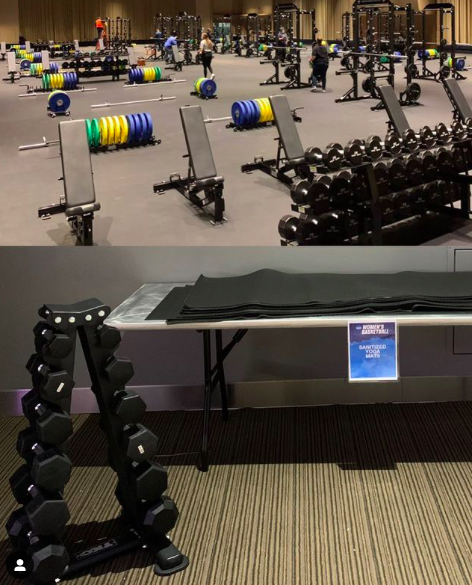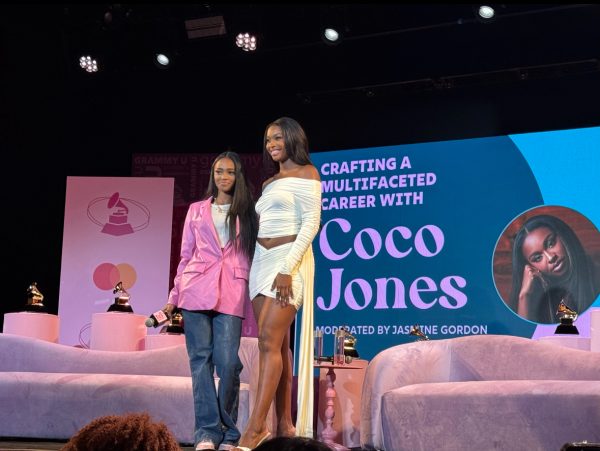March Madness’ Weight Room Debacle Ignites Discussion Over Gender Equality in Collegiate Sports

Stanford University sports performance coach Ali Kershner posted this photo on Instagram on March 18. The men’s weight room is pictured above and the women’s below. (Courtesy of Instagram)
After a long hiatus due to the ongoing coronavirus pandemic, the NCAA’s March Madness basketball tournament has made its highly-anticipated return this year. The 2021 national championships have already seen many twists and turns, such as No. 15 seed Oral Roberts taking down top-seeded Ohio State and the University of Florida, and UConn’s superstar freshmen Paige Bueckers and University of Iowa’s Caitlin Clark showdown in the Sweet Sixteen. However, the discrepancies between the treatment of the men’s and women’s teams overshadowed the tournament this year and raised serious questions around the NCAA’s behavior towards its female athletes.
The NCAA held this year’s March Madness in two different locations for the tournaments in accordance with COVID-19 protocols, with the men in Indianapolis, Indiana and the women in San Antonio, Texas. Athletes and coaches alike immediately recognized significant differences between the accommodations of the men and women’s hotel setups. It’s madness, and not because of March.
On Thursday, March 18, Stanford University sports performance coach Ali Kershner posted a photo of the women’s “weight room” that sent the entire athletics world into an uproar. The NCAA provided men’s teams with an enormous makeshift gym filled with power racks and Olympic bars and weights. Meanwhile, the women received only a single rack of dumbbells and a few sanitized yoga mats.
“@ncaawbb @ncaa @marchmadness this needs to be addressed. ” Kershner wrote in the caption. “These women want and deserve to be given the same opportunities. Not only that — 3 weeks in a bubble and no access to [dumbbells] above 30 [pounds] until the Sweet 16? In a year defined by a fight for equality, this is a chance to have a conversation and get better.”
The differences did not stop there. The NCAA mandated that athletes stay inside their respective “bubble” hotels to reduce potential exposure to the coronavirus, and the quarantine meals for the men and women differed immensely. Female players received small, pre-packaged meals crammed into paper bags while male players enjoyed option-friendly buffets. In addition, UConn women’s basketball head coach Geno Auriemma revealed that officials used cheaper, less-accurate COVID-19 antigen tests for the female teams. On the other hand, the male teams received trusted PCR tests.
Even worse, images started surfacing of the men’s and women’s complimentary swag bags for competing in the tournament, showing an enormous difference. The women’s gift consisted of a single t-shirt, one pair of socks, two water bottles, a small puzzle and a towel emblazoned with “Women’s Basketball.” Meanwhile, the men’s teams received multiple t-shirts, books, socks, hats, towels and more. Interestingly, the men’s swag bags were emblazoned with the words “the Big Dance,” whereas the women’s were only labeled with “NCAA Women’s Basketball.”
Lynn Holzman, the NCAA’s vice president for women’s basketball, issued a statement on March 18 blaming COVID-19 protocols for the disparity in amenities. “We acknowledge that some of the amenities teams would typically have access to have not been as available inside the controlled environment,” Holzman wrote. “This is due to the limited space and the original plan was to expand the workout area once additional space was available later in the tournament.” They also claimed that the swag bags were equal in monetary value and that they addressed the quality of the women’s food immediately.
However, the University of Oregon’s star forward Sedona Prince quickly disproved the NCAA’s claims of not having enough space. She posted a TikTok explaining the situation and revealed wide, empty practice courts with more than enough room for a sufficient weight room. “If you’re not upset about this problem, then you are a part of it,” Prince said at the end of the video.
The TikTok quickly went viral, with athletes and sports fans alike expressing their disappointment in the NCAA’s actions. “Women’s @NCAA bubble weight room vs [the] Men’s weight room… thought this was a joke,” tweeted Sabrina Ionescu, one of Prince’s former teammates who now plays for the New York Liberty. “WTF is this?!? To all the women playing in the @marchmadness tournament, keep grinding!” Stephen Curry, a star shooter for the NBA’s Golden State Warriors, retweeted Prince’s TikTok and expressed his disappointment, saying, “wow — come on now! @marchmadness @NCAA yall trippin’ trippin’.”
After facing immense backlash from the public, the NCAA upgraded the women’s weight room overnight. The setup now features significantly larger racks, Olympic bench presses, stationary bikes and more. NCAA President Mark Emmert vowed to never repeat this mistake during an interview with reporters on Friday. “I want to be really clear, this is not something that should have happened,” he said. “And, should we ever conduct a tournament like this again, [it] will [never] happen again.” Nevertheless, many people see the NCAA’s actions as too little, too late. They questioned why the NCAA did not provide the weight room in the first place and remarked that it should not have taken immense public scrutiny to have it installed.
The entire situation further pushes a narrative that women’s sports are undesired and less important than men’s. While the men’s tournament does bring in more money and attention, statistics show that interest in the women’s tournament is higher than ever, with participation in ESPN’s Women’s Tournament Bracket Challenge increasing by 103% since 2019’s championship. It is up to the NCAA to help increase audience engagement in women’s sports as a whole by providing widespread viewership options and substantial advertising. Nevertheless, women still struggle to have the organization consider them as equals, which inevitably creates additional barriers between women’s sports and the forefront of mainstream media.
One should hope that the NCAA’s blunder brings about substantial change for the treatment of female athletes in America’s collegiate scene. The NCAA should give its female athletes more support rather than disinterest, as they deserve all the glory their male counterparts receive.










































































































































































































